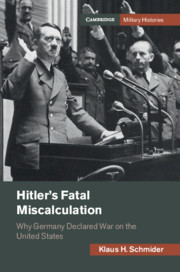Refine search
Actions for selected content:
15401 results in Military history
9 - The Luftwaffe on the Eve of Global War
-
- Book:
- Hitler's Fatal Miscalculation
- Published online:
- 08 January 2021
- Print publication:
- 28 January 2021, pp 484-522
-
- Chapter
- Export citation
Maps
-
- Book:
- Hitler's Fatal Miscalculation
- Published online:
- 08 January 2021
- Print publication:
- 28 January 2021, pp ix-x
-
- Chapter
- Export citation
6 - The Crisis of the German War Economy, 1940–1941
-
- Book:
- Hitler's Fatal Miscalculation
- Published online:
- 08 January 2021
- Print publication:
- 28 January 2021, pp 298-320
-
- Chapter
- Export citation
Abbreviations and German and Russian Terms
-
- Book:
- Hitler's Fatal Miscalculation
- Published online:
- 08 January 2021
- Print publication:
- 28 January 2021, pp xv-xviii
-
- Chapter
- Export citation
Epigraph
-
- Book:
- Hitler's Fatal Miscalculation
- Published online:
- 08 January 2021
- Print publication:
- 28 January 2021, pp v-vi
-
- Chapter
- Export citation
Introduction
-
- Book:
- Hitler's Fatal Miscalculation
- Published online:
- 08 January 2021
- Print publication:
- 28 January 2021, pp 1-10
-
- Chapter
- Export citation
2 - Hitler’s Physical Health in Autumn 1941
-
- Book:
- Hitler's Fatal Miscalculation
- Published online:
- 08 January 2021
- Print publication:
- 28 January 2021, pp 57-69
-
- Chapter
- Export citation
Figures
-
- Book:
- Hitler's Fatal Miscalculation
- Published online:
- 08 January 2021
- Print publication:
- 28 January 2021, pp viii-viii
-
- Chapter
- Export citation
3 - ‘All Measures Short of War’: the German Assessment of American Strategy, 1940–1941
-
- Book:
- Hitler's Fatal Miscalculation
- Published online:
- 08 January 2021
- Print publication:
- 28 January 2021, pp 70-162
-
- Chapter
- Export citation
4 - Forging an Unlikely Alliance: Germany and Japan, 1933–1941
-
- Book:
- Hitler's Fatal Miscalculation
- Published online:
- 08 January 2021
- Print publication:
- 28 January 2021, pp 163-267
-
- Chapter
- Export citation
10 - The Holocaust
-
- Book:
- Hitler's Fatal Miscalculation
- Published online:
- 08 January 2021
- Print publication:
- 28 January 2021, pp 523-542
-
- Chapter
- Export citation
1 - Hitler’s Pre-War Assessment of the United States and Japan
-
- Book:
- Hitler's Fatal Miscalculation
- Published online:
- 08 January 2021
- Print publication:
- 28 January 2021, pp 11-56
-
- Chapter
- Export citation

Hitler's Fatal Miscalculation
- Why Germany Declared War on the United States
-
- Published online:
- 08 January 2021
- Print publication:
- 28 January 2021
Introduction
-
- Book:
- PCE 1604 Series, Frigate Panter
- Published by:
- Amsterdam University Press
- Published online:
- 27 March 2024
- Print publication:
- 08 January 2021, pp 2-56
-
- Chapter
- Export citation
Frontmatter
-
- Book:
- PCE 1604 Series, Frigate Panter
- Published by:
- Amsterdam University Press
- Published online:
- 27 March 2024
- Print publication:
- 08 January 2021, pp 1-1
-
- Chapter
- Export citation
3 - Thailand’s Military: Ideology and Sense of Mission
-
-
- Book:
- Praetorians, Profiteers or Professionals?
- Published by:
- ISEAS–Yusof Ishak Institute
- Published online:
- 09 October 2021
- Print publication:
- 18 December 2020, pp 70-96
-
- Chapter
- Export citation
4 - The Defence Expenditures and Commercial Interests of the Tatmadaw
-
-
- Book:
- Praetorians, Profiteers or Professionals?
- Published by:
- ISEAS–Yusof Ishak Institute
- Published online:
- 09 October 2021
- Print publication:
- 18 December 2020, pp 97-131
-
- Chapter
- Export citation
5 - The Economic Role of the Thai Military: A Commercial Logic to Coups?
-
-
- Book:
- Praetorians, Profiteers or Professionals?
- Published by:
- ISEAS–Yusof Ishak Institute
- Published online:
- 09 October 2021
- Print publication:
- 18 December 2020, pp 132-149
-
- Chapter
- Export citation
Frontmatter
-
- Book:
- Praetorians, Profiteers or Professionals?
- Published by:
- ISEAS–Yusof Ishak Institute
- Published online:
- 09 October 2021
- Print publication:
- 18 December 2020, pp i-iv
-
- Chapter
- Export citation
Acknowledgements
-
- Book:
- Praetorians, Profiteers or Professionals?
- Published by:
- ISEAS–Yusof Ishak Institute
- Published online:
- 09 October 2021
- Print publication:
- 18 December 2020, pp vi-vi
-
- Chapter
- Export citation
